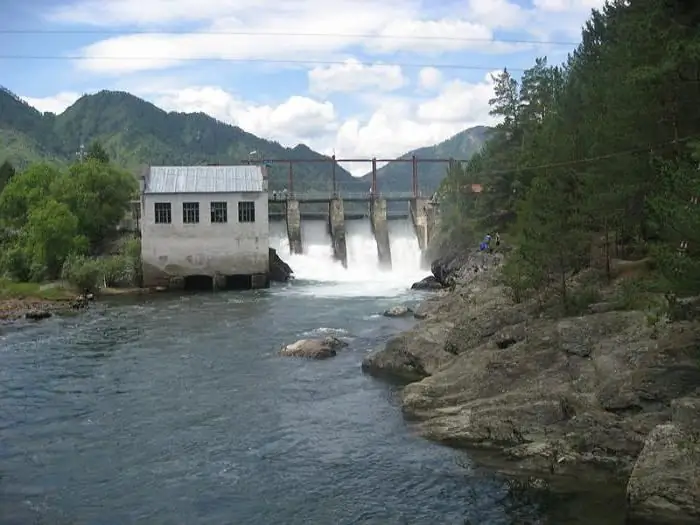- Author Harold Hamphrey [email protected].
- Public 2023-12-17 10:06.
- Last modified 2025-01-24 11:10.
The largest island in the B altic Sea is Gotland. It is about 100 km away from the mainland of Sweden and is the largest island of this country. The total area of Gotland is 2994 square kilometers. The island is presented in the form of a plateau composed of sandstones and Silurian limestones. The highest point in Gotland is Loista Head (83 m). The prevailing heights on the island do not exceed 50 m. Visby is the main port and city of the island, where many attractions are concentrated.
History of the main city of the island
When exactly the main city of modern Gotland, Visby, was born, it is not known for certain. However, there are facts that indicate that the settlement existed here in the Stone Age. The Vikings were the first inhabitants of Visby. And the name of the settlement literally translates as “village near Vi.”
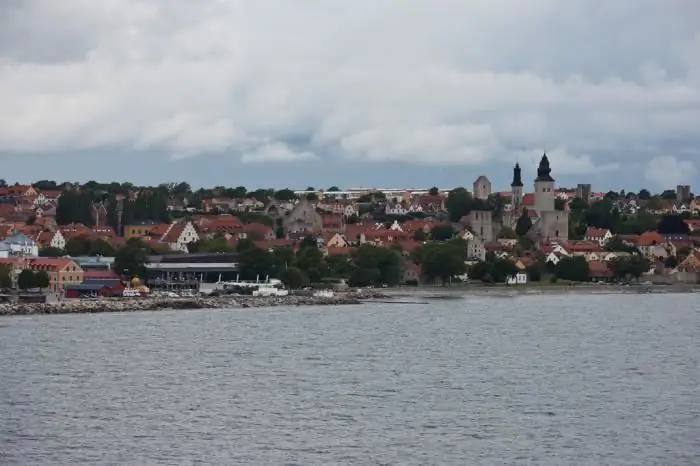
The city began to develop most actively during the Middle Ages. The 12th century was the time of the construction of numerous Christian churches. In the same period, various monastic orders erected many schools. However, until now, none ofthese buildings were not preserved, only ruins remained from some of them. The greatest damage was done to the city's churches and schools during the Lübeck invasion of the island of Gotland in the 16th century. Then only the Cathedral of St. Mary managed to survive.
Visby flourished in the 13th century. Then the city was part of the mighty Hanseatic League, as well as the most important economic and commercial center of Europe. It was at that time that the construction of the fortress ring wall began, which today surrounds the Swedish town.
The 14th-16th centuries were marked for Visby by numerous troubles - plague, famine due to crop failures, invasions by the Swedish king, conquest by pirates, many years of enmity between local merchants and merchants from Lübeck, as a result of which the city was burned to the ground by the latter. Economic and cultural life in Visby was established only in the 19th century. This was due to the emergence of local residents' interest in their historical monuments. Today, the city is a popular tourist resort among travelers from all over the world.
Raukari - the most famous natural attractions of Gotland
The fact that Gotland is the largest island in the B altic Sea is not its only feature. After all, on its territory there are one of the most famous natural wonders of the world - raukars. They are presented in the form of bizarrely shaped pillars that amaze with their grandeur and beauty. Their formation was facilitated by such natural elements as water and wind, constantly affecting the coastal rocks. The largest raukar, which has on itsterritory of the island of Gotland, is Hoburgsgubben. It is located at a distance of about 100 km from Visby. From afar, this raucar resembles an old man's head.
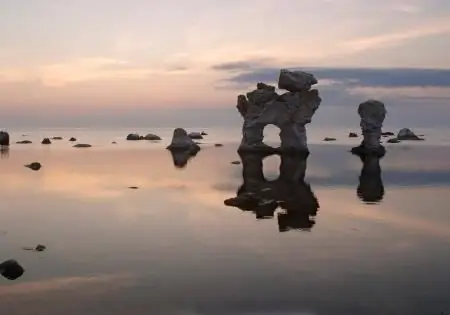
Not far from Lergrav Bay is the raukar area Lergrav raukomrade, which is 1000 meters long and 200 meters wide. Here vacationers love to wander, reflecting on the meaning of life. The most famous raukar in the area is Porten. Not far from here is a fishing village, where tourists often come to look at the preserved old furnace, in which lime was once burned.
Gotland Botanical Garden
The Botanical Garden is another famous attraction that the island of Gotland (Sweden) has on its territory. It was founded in 1856 by the Society of Bathing Lovers - a gentlemen's club formed for the purpose of charity. By the way, the first school and bank in Gotland were founded by the same society. The botanical garden is located next to the Gates of Love in the northwestern part of the city wall.
Tourists who visit the park between July and August have the opportunity to enjoy the scents that come from the many herbs, trees and the rose garden. Plants exotic for the Scandinavian countries grow on the territory of the botanical garden, including mulberry, walnut, ginkgo and many others. Among the lush vegetation of the park are the ruins of St. Olof's church and a pond with many water lilies, where visitors to the object like to relax.
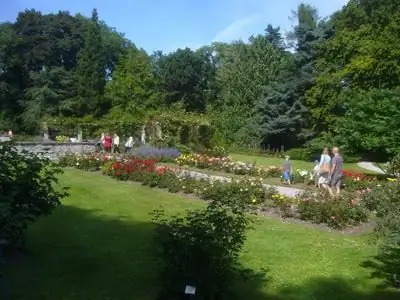
Museums of Gotland
The History Museum is another attraction located on the island of Gotland (Sweden). Everything about Gotland, or at least a lot, you can find out right here! The museum contains many archaeological finds of the Viking Age, exhibits of the Stone and Middle Ages, huge collections of silver and gold treasures. The permanent exhibition called Gotlandium provides visitors with comprehensive information about the formation of the island of Gotland, the gradual change in its landscape, and the features of the formation of raukars. The smallest tourists who came to the island of Gotland with their parents are delighted with what they see in the center of modern science - Fenomenalen.
Another place worth visiting is the art gallery located in the center of Visby. It occupies a separate building erected in the middle of the century before last. The museum's collection includes the finest works of art that depict the beauty of Gotland. Often temporary exhibitions of contemporary artists are organized here.
For lovers of vintage vehicles, the car museum, which was created by enthusiast Mats Andersson, is also worth a visit. Here you can see cars and motorcycles that were produced between the 19th and 20th centuries.
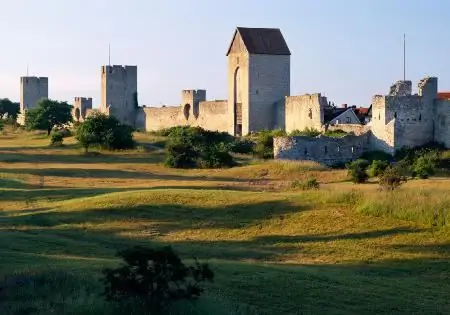
City Wall
The city wall is the brightest man-made object that the island of Gotland has on its territory. The sights of many other cities located in Northern Europe are dimmingcompared to her. The wall is 3.5 km long and 11 m high. It was built of sandstone at the end of the 13th century. The towers of the 12th-14th centuries adorn the wall, there are about 30 of them. The oldest is the Powder Tower (Kruttornet), whose height is 18 m. In the summer months, tourists have the opportunity to visit this object.
St. Mary's Cathedral and the ruins of St. Nicholas Monastery
The Cathedral of St. Mary is the only object that has survived to this day, erected here in the Middle Ages. Moreover, worship services are held in it today. The cathedral is one of the most ancient buildings that have been preserved in the city of Visby, and, by the way, there are not so many of them. The church was erected in 1225 at the expense of merchants and sailors from Germany. In the same year it was consecrated by Bishop Berngt Magnusson of Linkoping. The cathedral was originally a Romanesque basilica with a western tower, an apse and a transept. However, as a result of numerous reconstructions, the church became larger in area, and two eastern towers and choirs appeared in it. The status of a cathedral was given to it in 1572.
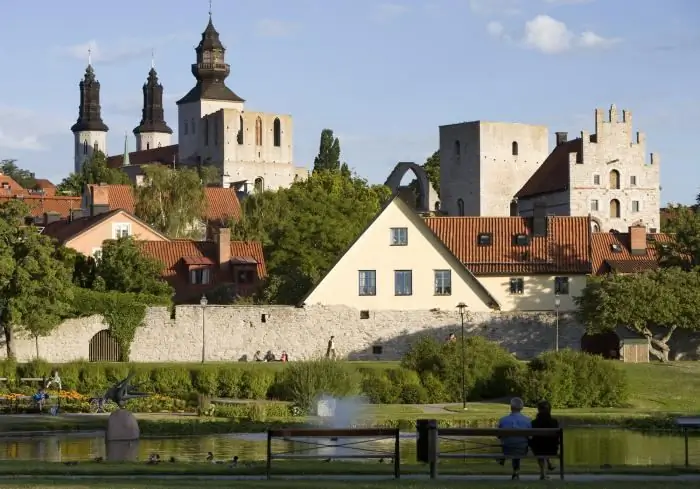
There were many other holy places on the territory of Gotland, but nothing remained of most of them, and only ruins of some. It is among the latter that the monastery of St. Nicholas, founded in Visby in 1228, belongs. Today, theatrical and musical performances are often organized among its ruins, and the Gotland Chamber Music Festival is held annually, whichattracts fans of this musical direction not only from Sweden, but also from many other countries of the world.




